 Backend Development
Backend Development
 Python Tutorial
Python Tutorial
 Python 3.10 is released! You should know these 5 new features
Python 3.10 is released! You should know these 5 new features
Python 3.10 is released! You should know these 5 new features
Python has been in the market for a while now, and as a Python developer, I am happy to share that Python is gradually getting updates and improvements with each new version. The latest version of Python, 3.10, has some major improvements, and I'll list those updates here. I've listed the first 5 updates for this new version.
1. Improvements in error messages
For Python developers, when you write code and encounter an error, error messages can help you find the error in the code. Improved error messages make your life easier than when using previous Python versions. For example, consider the following code, where there are no brackets at the end of the second line:

# In previous versions - Python 3.9 and earlier, you would see the following Error -

Well, invalid syntax! Now, as a developer, what do you understand from this error message? Well, personally, I don't understand anything except the fact that somewhere on line 3 I added wrong syntax.
But, does the error really appear on line 3? Python 3.10 is the savior in this case, with the latest updates. For the same piece of code, Python 3.10 will throw the following error message -

The line number and very specific error message will allow you to jump right in, fix the error, and continue coding! Another example of my personal attempt to see if the error message is clear enough -
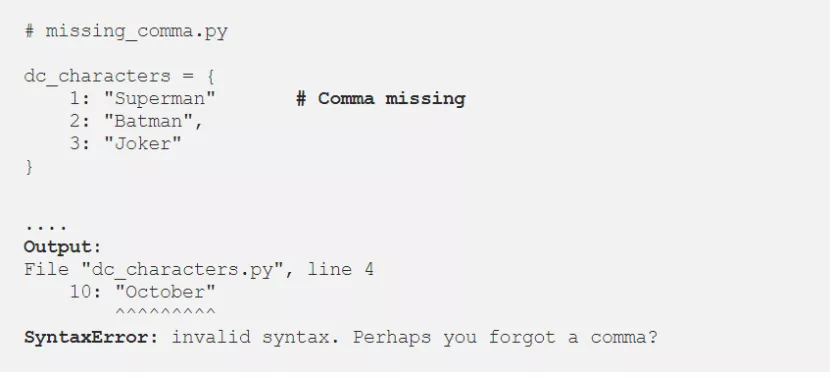
This is really a cool update in the Python 3.10 version, please leave a comment on this article Share your thoughts on this section.
2. Simpler type union syntax
In past Python versions, more tools have moved from type conversion to built-in functions to avoid importing static types every time. Now look at this change -
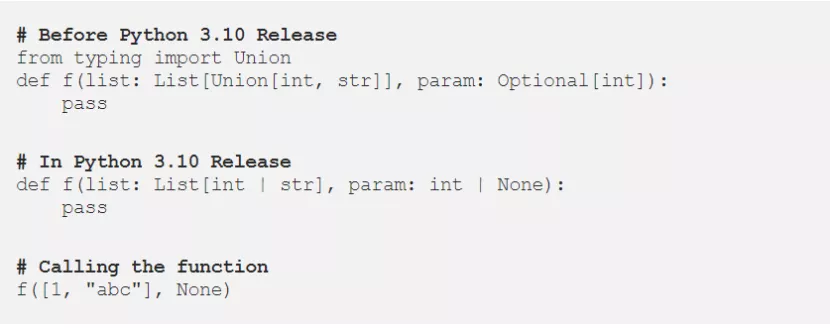
In Python 3.10, you are now allowed to use the pipe operator (|) to specify type unions instead of from the input module Import union. In addition, the existing typing.Union and | syntax should be equivalent, as compared with the following -

3. Use multiple `with` statements in multiple lines
Python does support multi-line statements through the use of backslash(), but some constructs in Python do not require the use of slashes to write multi-line statements. One of them is a context manager with a multi-line with() statement. For example -
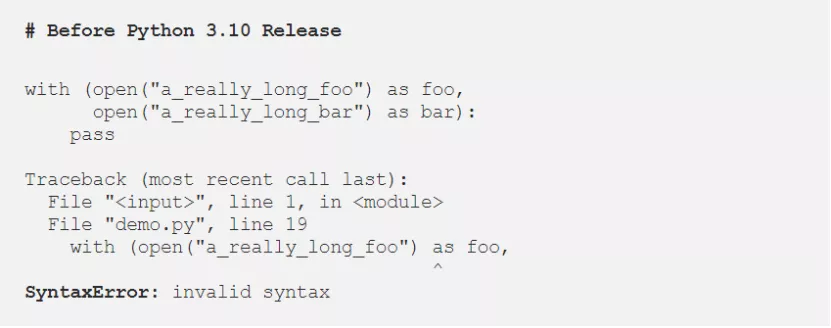
Yes, this may not seem like a feature, but it is a significant improvement over previous versions as you may have encountered using multi-line context managers use case, but failed to execute due to the above error. If you're still confused, let's give some more examples of what you can do with the Python 3.10 version of the context manager -
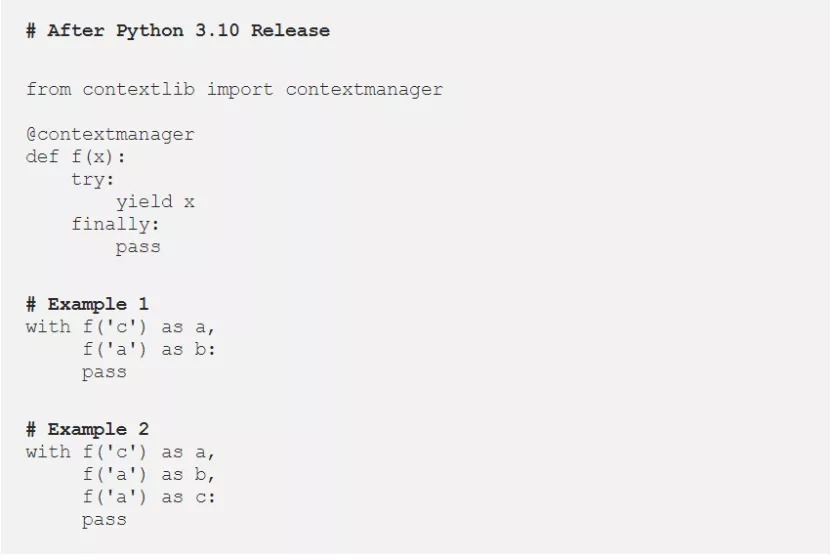
You can now have multi-line contexts manager statement without using backslashes. Great, right?
4. Better type aliases
Type aliases allow you to quickly define new aliases that can be created for complex type declarations. For example -

This usually works fine. However, it is usually impossible for a type checker to know whether such a statement is a type alias or just a definition of a regular global variable.

The above python code declares an alias UserInfo for tuple[str, str] because it is a data type that combines values of multiple types. In our case it's a string and an integer. Additionally, adding TypeAlias annotations clarifies intent to the type checker and anyone reading your code.
5. Stricter sequence compression
zip() is a built-in function in Python that you may have used when combining multiple lists/sequences. Python 3.10 introduces the new strict parameter, which adds a runtime test to check that all compressed sequences have the same length. For example -

zip() can be used to iterate these three lists in parallel:

Let’s use the above again The names and numbers of the two sequences are displayed. Now the only difference is that the numbers between these sequences are different lengths of the sequence names as shown below -
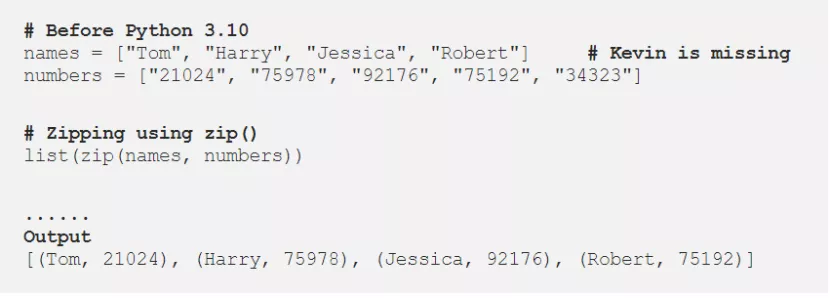
Note that all the information about the name - Kevin Gone! If your data set is larger, it will be harder to find such errors. Even if you find a problem, diagnosing and fixing it isn't always easy. The assumption that the compressed sequences will be of the same length not only helps you avoid this discrepancy. In Python 3.10, the strict parameter can help you avoid this situation in the first place -
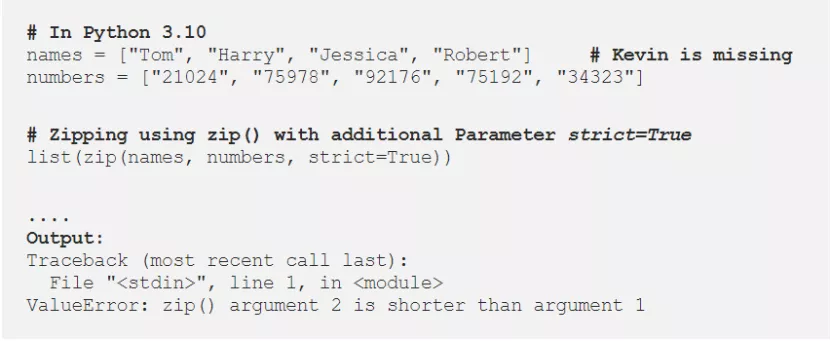
While strict doesn't really add any new functionality to zip(), It helps you avoid those hard-to-find mistakes.
Other updates in Python 3.10 This version has a lot of bug fixes as well as some other small updates, which can be found on the official release page if you are interested.
Original text: https://varun-singh-01.medium.com/python-3-10-released-top-5-new-features-you-should-know-bf968ac99230
The above is the detailed content of Python 3.10 is released! You should know these 5 new features. For more information, please follow other related articles on the PHP Chinese website!

Hot AI Tools

Undresser.AI Undress
AI-powered app for creating realistic nude photos

AI Clothes Remover
Online AI tool for removing clothes from photos.

Undress AI Tool
Undress images for free

Clothoff.io
AI clothes remover

AI Hentai Generator
Generate AI Hentai for free.

Hot Article

Hot Tools

Notepad++7.3.1
Easy-to-use and free code editor

SublimeText3 Chinese version
Chinese version, very easy to use

Zend Studio 13.0.1
Powerful PHP integrated development environment

Dreamweaver CS6
Visual web development tools

SublimeText3 Mac version
God-level code editing software (SublimeText3)

Hot Topics
 1379
1379
 52
52
 PHP and Python: Code Examples and Comparison
Apr 15, 2025 am 12:07 AM
PHP and Python: Code Examples and Comparison
Apr 15, 2025 am 12:07 AM
PHP and Python have their own advantages and disadvantages, and the choice depends on project needs and personal preferences. 1.PHP is suitable for rapid development and maintenance of large-scale web applications. 2. Python dominates the field of data science and machine learning.
 How to train PyTorch model on CentOS
Apr 14, 2025 pm 03:03 PM
How to train PyTorch model on CentOS
Apr 14, 2025 pm 03:03 PM
Efficient training of PyTorch models on CentOS systems requires steps, and this article will provide detailed guides. 1. Environment preparation: Python and dependency installation: CentOS system usually preinstalls Python, but the version may be older. It is recommended to use yum or dnf to install Python 3 and upgrade pip: sudoyumupdatepython3 (or sudodnfupdatepython3), pip3install--upgradepip. CUDA and cuDNN (GPU acceleration): If you use NVIDIAGPU, you need to install CUDATool
 How is the GPU support for PyTorch on CentOS
Apr 14, 2025 pm 06:48 PM
How is the GPU support for PyTorch on CentOS
Apr 14, 2025 pm 06:48 PM
Enable PyTorch GPU acceleration on CentOS system requires the installation of CUDA, cuDNN and GPU versions of PyTorch. The following steps will guide you through the process: CUDA and cuDNN installation determine CUDA version compatibility: Use the nvidia-smi command to view the CUDA version supported by your NVIDIA graphics card. For example, your MX450 graphics card may support CUDA11.1 or higher. Download and install CUDAToolkit: Visit the official website of NVIDIACUDAToolkit and download and install the corresponding version according to the highest CUDA version supported by your graphics card. Install cuDNN library:
 Detailed explanation of docker principle
Apr 14, 2025 pm 11:57 PM
Detailed explanation of docker principle
Apr 14, 2025 pm 11:57 PM
Docker uses Linux kernel features to provide an efficient and isolated application running environment. Its working principle is as follows: 1. The mirror is used as a read-only template, which contains everything you need to run the application; 2. The Union File System (UnionFS) stacks multiple file systems, only storing the differences, saving space and speeding up; 3. The daemon manages the mirrors and containers, and the client uses them for interaction; 4. Namespaces and cgroups implement container isolation and resource limitations; 5. Multiple network modes support container interconnection. Only by understanding these core concepts can you better utilize Docker.
 Python vs. JavaScript: Community, Libraries, and Resources
Apr 15, 2025 am 12:16 AM
Python vs. JavaScript: Community, Libraries, and Resources
Apr 15, 2025 am 12:16 AM
Python and JavaScript have their own advantages and disadvantages in terms of community, libraries and resources. 1) The Python community is friendly and suitable for beginners, but the front-end development resources are not as rich as JavaScript. 2) Python is powerful in data science and machine learning libraries, while JavaScript is better in front-end development libraries and frameworks. 3) Both have rich learning resources, but Python is suitable for starting with official documents, while JavaScript is better with MDNWebDocs. The choice should be based on project needs and personal interests.
 How to choose the PyTorch version under CentOS
Apr 14, 2025 pm 02:51 PM
How to choose the PyTorch version under CentOS
Apr 14, 2025 pm 02:51 PM
When selecting a PyTorch version under CentOS, the following key factors need to be considered: 1. CUDA version compatibility GPU support: If you have NVIDIA GPU and want to utilize GPU acceleration, you need to choose PyTorch that supports the corresponding CUDA version. You can view the CUDA version supported by running the nvidia-smi command. CPU version: If you don't have a GPU or don't want to use a GPU, you can choose a CPU version of PyTorch. 2. Python version PyTorch
 How to install nginx in centos
Apr 14, 2025 pm 08:06 PM
How to install nginx in centos
Apr 14, 2025 pm 08:06 PM
CentOS Installing Nginx requires following the following steps: Installing dependencies such as development tools, pcre-devel, and openssl-devel. Download the Nginx source code package, unzip it and compile and install it, and specify the installation path as /usr/local/nginx. Create Nginx users and user groups and set permissions. Modify the configuration file nginx.conf, and configure the listening port and domain name/IP address. Start the Nginx service. Common errors need to be paid attention to, such as dependency issues, port conflicts, and configuration file errors. Performance optimization needs to be adjusted according to the specific situation, such as turning on cache and adjusting the number of worker processes.
 How to operate distributed training of PyTorch on CentOS
Apr 14, 2025 pm 06:36 PM
How to operate distributed training of PyTorch on CentOS
Apr 14, 2025 pm 06:36 PM
PyTorch distributed training on CentOS system requires the following steps: PyTorch installation: The premise is that Python and pip are installed in CentOS system. Depending on your CUDA version, get the appropriate installation command from the PyTorch official website. For CPU-only training, you can use the following command: pipinstalltorchtorchvisiontorchaudio If you need GPU support, make sure that the corresponding version of CUDA and cuDNN are installed and use the corresponding PyTorch version for installation. Distributed environment configuration: Distributed training usually requires multiple machines or single-machine multiple GPUs. Place



